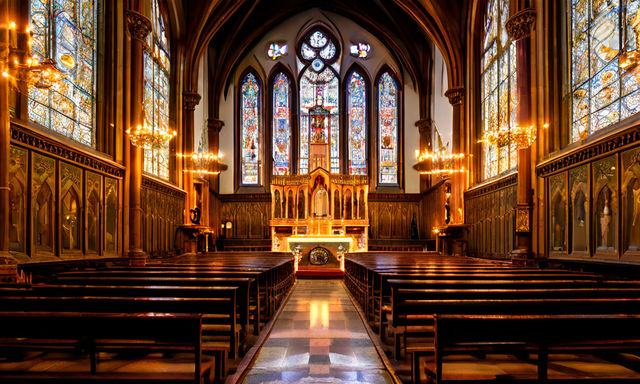
The Church Tabernacle: A Dwelling Place for the Divine Presence
|
|
Time to read 6 min
|
|
Time to read 6 min
Within the grand architecture and hushed reverence of a church, a specific space holds a unique significance. The tabernacle, often adorned and strategically placed, serves as a focal point for devotion and a silent testament to a core Christian belief. This in-depth exploration delves into the world of the church tabernacle, examining its:
By understanding the multifaceted purpose of the tabernacle, we gain a deeper appreciation for the rich tapestry of Christian beliefs and practices.
The concept of a designated space for the divine presence has roots in the Old Testament. The Tabernacle , a portable tent-like structure, served as the dwelling place for God among the Israelites during their wanderings in the desert (Exodus 25-27). This portable sanctuary housed the Ark of the Covenant, believed to contain the Ten Commandments and symbolizing God's presence with his people.
From Nomadic Dwelling to Church Fixture:
With the establishment of permanent temples in Jerusalem, the concept of a designated dwelling place for God transitioned from a portable structure to a designated room within the temple, known as the Holy of Holies . This innermost sanctum, accessible only to the High Priest, housed the Ark of the Covenant.
The Early Church and the Reservation of the Eucharist:
The concept of a designated space for the divine presence took on new meaning in early Christianity. Following the Last Supper, where Jesus instituted the Eucharist, Christians began the practice of reserving consecrated bread for future use, particularly for the sick and those unable to attend regular services. Initially, simple containers like baskets or wooden boxes served this purpose.
The Rise of the Tabernacle:
By the 4th century AD, the practice of reserving the Eucharist became more formalized. This led to the development of a dedicated container, the tabernacle, specifically designed to house the consecrated bread. Initially, these tabernacles were often simple and placed within a locked chamber or a niche in the wall.
The Middle Ages and Beyond:
The Middle Ages witnessed a shift in tabernacle design and placement. As the belief in the Real Presence of Christ in the Eucharist gained prominence, tabernacles became more elaborate and prominent features within churches. They were often constructed from precious metals, adorned with intricate carvings and artwork, and positioned on the main altar or in a dedicated side chapel.
Post-Reformation and Modern Trends:
The Protestant Reformation in the 16th century challenged the concept of the Real Presence. This led to a decline in the use of tabernacles in Protestant churches. However, the Catholic Church continued the tradition, with tabernacles remaining a central focus in Catholic worship spaces. Modern trends in church design sometimes incorporate more understated tabernacles, focusing on functionality while maintaining a sense of reverence.
The concept of the tabernacle is deeply intertwined with the Christian belief in the Real Presence of Christ in the Eucharist. This theological doctrine holds that the consecrated bread and wine become the body and blood of Christ after the act of blessing during the Eucharist.
A Dwelling Place for the Divine:
The tabernacle, therefore, becomes more than just a storage container. It serves as a designated dwelling place for the divine presence of Christ, offering a focal point for prayer, meditation, and adoration.
Accessibility and Perpetual Adoration:
The placement of the tabernacle within the church allows believers to access the Real Presence of Christ outside of scheduled services. This fosters a sense of constant connection with the divine and enables practices like perpetual adoration, where dedicated individuals or groups take turns praying before the tabernacle throughout the day and night.
The tabernacle plays a vital role in Eucharistic practices within Christian denominations that believe in the Real Presence. Here's a breakdown of its liturgical function:
Liturgical Regulations:
Church regulations typically govern the use and care of the tabernacle. These may include:
The design and placement of the tabernacle are not merely functional; they carry rich symbolism:
Artistic Styles Through the Ages:
Throughout history, tabernacles have been adorned with beautiful and meaningful artwork, reflecting the artistic styles of their time periods. Here are some examples:
The artistic expression on a tabernacle can serve as a visual aid for prayer and contemplation, deepening the believer's connection with the divine presence within.
When choosing or maintaining a tabernacle, churches consider several factors:
Considerations for Perpetual Adoration Chapels:
Churches with dedicated perpetual adoration chapels may have additional considerations:
The church tabernacle stands as a silent yet powerful symbol of faith. It embodies the belief in the Real Presence of Christ, offering a focal point for prayer, adoration, and a deeper connection with the divine. By understanding its rich history, multifaceted symbolism, and practical considerations, we gain a richer appreciation for this sacred space within the Christian tradition.